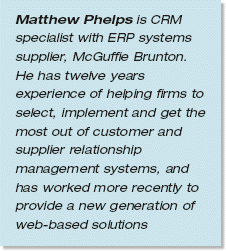 Customer relationship management (CRM) is something that all commercial organisations do, in one form or another. The desire to introduce a system that provides a toolkit for sales, marketing and customer service personnel to access and manage a wide range of information and intelligence on customers has moved up the management agenda.
Customer relationship management (CRM) is something that all commercial organisations do, in one form or another. The desire to introduce a system that provides a toolkit for sales, marketing and customer service personnel to access and manage a wide range of information and intelligence on customers has moved up the management agenda. From my own experience, the company I work for is seeing one out of every two new ERP system customers buy into CRM and implement it alongside, or as integral part of their main business systems. This is a logical step to take as customer management is part and parcel of a companys commercial activity; in the same vein as manufacturing and operations.
At first glance, installing CRM software is a daunting task and historically a struggle for many firms. So what is driving this latest need, and how can manufacturers and logistics businesses successfully introduce CRMand avoid those past pitfalls?
For the first part, I would suggest that there are two key driving factors. First of all, businesses are increasingly competitive. The cost of losing a customer is higher than say two years ago and customers are much harder to replace. Secondly, the latest ERP systems are providing firms with more robust, reliable applications, as well as annual, incremental improvements in managing and controlling their activities.
Manufacturing, financial, and distribution systems offer clear procedures and a structure and framework that deliver efficiency and control to a companys operations and allow senior management to sweat their assets. The same can be done with sales and marketing.
Integrating CRM with the main business systems makes sense when you consider that sales and marketing has an interest in operational information, i.e. turnover, sales order processing, stock holding, etc., that is held centrally.
But to what extent do you integrate your systems and go about getting the best out of them? So often in the past a CRM project has started with an attempt to duplicate the existing processesand to identify which fields will hold what data, who can see what and so on. In truth, these are not the places to start.
Ask yourself these questions
Why are you committing time and money to purchase a CRM system? In all probability you will wish to improve your business competitiveness in an increasingly aggressive market place.
What is the companys overall objective? Which departmental goals need to be met to support the organisations objective? And what targets should you set to show that the department is performing?
By starting with the overall objectives and working through the supporting goals a company can quickly identify what it needs from its CRM system and the activity that it supports.
How does this work? A typical goal might be to increase revenue and profit by a given factor. What share of that increase will come from existing customers? Will the remainder be found through winning new name business?
Taking the increase from an existing customer base as an example we can see that the departmental goal might be to identify those customers who are important to us; those who could be, as well as those who are unprofitable. With that goal in mind it is possible  to identify what information you need to judge which of the three categories a given customer will fall into. At this point you can detail the fields, and associated data, that the system must support. Remember, you can access the data held in your ERP modules to support this initial categorisation and subsequent reviews.
to identify what information you need to judge which of the three categories a given customer will fall into. At this point you can detail the fields, and associated data, that the system must support. Remember, you can access the data held in your ERP modules to support this initial categorisation and subsequent reviews.
Apply this approach to each department goal alongside the supporting targets and very quickly you can start to specify the configuration of your CRM system for your company and its objectives.

Add a Comment
No messages on this article yet